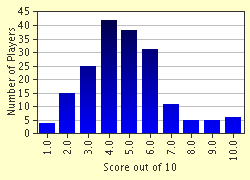Quiz Answer Key and Fun Facts
1. In his 'Art of War', Sun Tzu emphasises the importance of deception. In 341BC, the Ch'i general Sun Pin put these theories to good effect when invading the territory of Wei.
Which of these deceptions did Sun Pin use to gain victory of the Wei general P'ang Chuan?
2. Many lightly armed forces have made use of tactical deception to overcome more heavily armed troops. The feigned retreat has been particularly well used throughout history and is often cited as the tactic which won the Battle of Hastings for William the Conqueror.
However, one ancient civilisation used this tactic so effectively that it entered the English language to mean 'a wounding remark made on departure, with no time for reply'. What is this term?
3. Deception does not always occur on a grand scale. In 1805, two French marshals managed to prevent Austrian engineers demolishing the vital Tabor bridge through sheer bluff. They crossed the bridge, unarmed and in full dress uniform, claiming that an armistice had been reached between the French and Austrians. The Austrian commander was fooled and the bridge was taken without a single shot being fired.
Who were the two French marshals?
4. During the American Civil War, an army of 120,000 men under Major-General George B. McClellan was held off by just 8,000-15,000 Confederates under John Bankhead Magruder.
Magruder had only 15 guns to defend a 13 mile line but managed to make his defences seem more impressive by the use of 'Quaker guns'. What was a 'Quaker gun'?
5. Colonel Robert Baden-Powell, founder of the Boy Scouts movement, gained fame for his defence of Mafeking during the Second Anglo-Boer War. With a force of around 1,000 men facing around 8,000 Boers, Baden-Powell's general instructions to the garrison were 'bluff the enemy ... as much as you like'.
Which of these bluffs *didn't* aid the defenders of Mafeking in their 217 day resistance?
6. In preparing for the Tet Offensive, the North Vietnamese Army made obvious moves towards an isolated US garrison, prompting a movement of US troops away from the real objective of Tet.
What was the name of this US base?
7. The British army in 1942 prepared for the Battle of El Alamein by concealing the huge build-up of forces in the northern sector of the allied line whilst simulating a build-up in the south.
This deception plan, codenamed BERTRAM, used many techniques to mislead Germany reconnaissance. Which of these did it NOT use?
8. The British intelligence service (MI5) had great success finding German spies during World War II. These spies were often used as double agents, sending false information back to their German handlers.
Spaniard Juan Pujol Garcia was instrumental in convincing the German high command that the allied invasion would be aimed at Calais rather than Normandy.
What was Garcia's codename?
9. The Chinese People's Liberation Army prized deceptive skill and adopted guerrilla tactics in order to maximise their effect. One tactic used on an increasingly grand scale was called 'ch'ien niu' ('pulling a stupid cow').
What was this tactic?
10. Returning to ancient history, the Roman Dictator Quintus Maximus Fabius was faced by the great Carthaginian general Hannibal. Refusing to be drawn into a disadvantageous battle, Fabius kept to the high-ground and slowly forced Hannibal into the mountains.
When Fabius was awoken one night to see thousands of lights on the hillsides, apparently moving to escape, he suspected a trick and refused to be drawn. Instead he left the 4000 men details to hold the pass to deal with the situation.
Was Fabius correct in suspecting a trick and what was the result?
Source: Author
StuHern
This quiz was reviewed by FunTrivia editor
bloomsby before going online.
Any errors found in FunTrivia content are routinely corrected through our feedback system.

